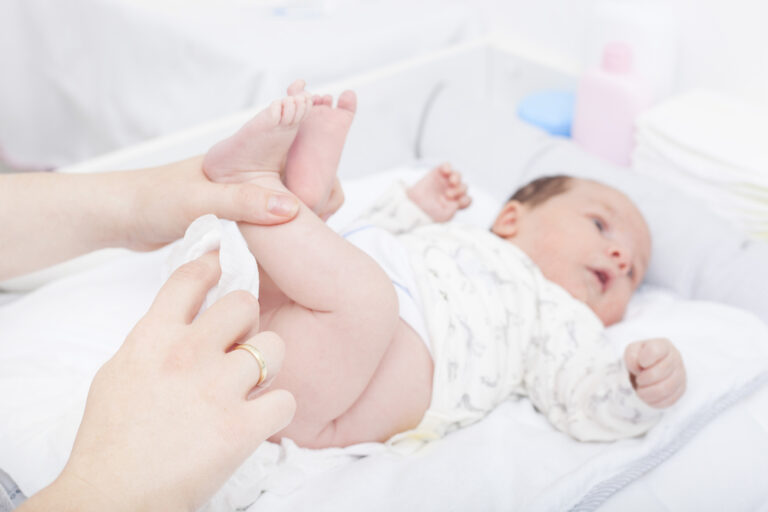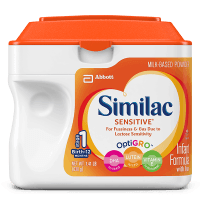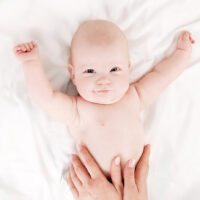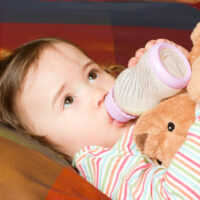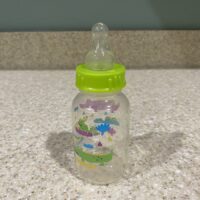At one time, baby powder was found in diaper bags and changing tables all across the world. Today, however, many pediatricians recommend against it. The AAP states that with baby powder (even without talc), there’s a high risk of aspiration (due to small particles) if you use it too close to your baby’s face and airways. Below, you’ll learn more about a safe alternative to using baby powder.
The Dangers of Baby Powder
Fine, dry particles from baby powder help keep the skin dry and prevent chafing, especially in areas susceptible to moisture. In recent years, however, there have been a lot of concerns about baby powder and its safety.
The initial concerns regarding baby powder were related to its possible contamination with cancer-causing asbestos. Talc mines and asbestos mines are close to each other, so cross-contamination happens very easily. Many brands that contain talc were tested and it was found that asbestos was in the product.
Even though many manufacturers have decided to phase out talc from their baby products (like manufacturer Johnson & Johnson that states all talc-based powders will be discontinued by May 2020), baby powder is still not recommended by the American Academy of Pediatrics. The AAP’s official statement is that powders should be avoided.
Even though the original concern was the potential presence of asbestos, now the issue is the fine particles that are released in the air when you use baby powder. These particles can be inhaled and result in aspiration of the airways. This also may happen more frequently than you think. One study published by the AAP reported an average of 50 calls to the New York Poison Control Center each year alone and aspirated baby powder has a 20% mortality rate.
Alternatives to Baby Powder
Cream-to-Powder
Since many brands have eliminated talc from their powder products, it’s easy to find dusting powder made with talc alternatives. However, even dusting powders have the same risk of being inhaled into the lungs.
Cream-to-powder diaper rash creams are wet when you apply them but they dry as a baby powder. This might be a good alternative for parents who like the smell of baby powder and how it leaves their baby’s skin feeling.
Diaper Rash Cream, Ointment, Lotion, or Paste
When you use a cream instead of a powder, there’s no risk of inhalation. Most creams contain zinc oxide, petroleum, or other ingredients that create a protective barrier on the skin. With the barrier, it makes it harder for moisture to penetrate (and irritate) your baby’s skin. (You can find our top choices for the best diaper rash cream here).
As you look at different types of diaper cream, keep in mind that baby’s sensitive bottoms usually tolerate a cream, paste, or ointment more than a lotion. Lotions are more likely to irritate the skin. Additionally, while a paste or ointment does protect the skin from moisture, it also doesn’t allow any air through. Creams dry on the skin and also let air through.
Oatmeal Baths
Oatmeal has anti-inflammatory and soothing benefits that relieve redness, swelling, or itching that might be associated with diaper rash. It also helps heal the skin’s natural barrier, which lets it retain moisture that is critical for healing.
The best type of oatmeal to use for an oatmeal bath is colloidal oatmeal. You can find these in packets designed just for oatmeal baths; they are not processed so they have the most benefits. Additionally, look for those that are free of fragrances or other additives that might irritate your baby’s skin condition. As your child gets older, you might also want to keep them on hand for eczema, chickenpox, bug bites, heat rash, poison ivy rash, sunburn, hives, and other skin afflictions.
One thing to note is that many types of oats do contain gluten. If your baby has a gluten allergy, then an oatmeal bath can make skin inflammation worse. If you aren’t sure if your baby has a gluten allergy or it runs in the family, do a small test area on your baby’s hand instead of putting them in a bath first.
Powder Alternatives
If you still want to use a powdering product on your baby, there are several talc-free alternatives. (You can learn more about our picks for best baby powder here). Some of the most common ingredients include:
Cornstarch
Odds are, you already have cornstarch in your kitchen at home. (I typically use it for thickening my sauces when I make Asian cuisine). It also works as an anti-sticking agent and absorbs moisture well, which makes it great for treating diaper rash.
Something to note about cornstarch, however, is that it can interact with certain types of candida bacteria and make diaper rash worse.
Kaolin
Kaolin is a white clay found in mineral mines all around the world. It is commonly used in the beauty industry because it cleans the pores while absorbing oil. It also has a fine, soft texture that is pleasant on the skin.
Tapioca
Tapioca starch comes from the Brazilian native cassava plant. While its earliest use was in cuisine in areas like South America and Africa, it also works well for absorbing moisture.
Arrowroot
This tropical root is cultivated in the Caribbean. Its high starch content made arrowroot a common choice for food and medicine until it became an export in the 1900s. While it has gained popularity as a nutrient-rich gluten alternative, arrowroot also makes a great baby powder. The silky texture and moisture-absorbing properties make it very similar to talc.
Baking Soda
Baking soda naturally absorbs odor, making it a natural choice for keeping your baby fresh. It is also a common additive in natural deodorants, where it works in place of aluminum. Something to keep in mind, however, is that using baking soda directly can harm your child’s delicate skin because of the grainy, abrasive texture.
*A Note About Using These Powder Alternatives
Even though these powder alternatives do not contain talc, they still should be used with caution. Most baby powder formulas on the market today do not contain talc. However, the American Academy of Pediatrics still recommends using alternatives because of the fine particles found in baby powder, talc, and other powdering products. They carry the same risk of being inhaled into the lungs as baby powder does.
Homeopathic Treatments for Diaper Rash
Alternative medicines have recommended several natural remedies for diaper rash. According to the Mayo Clinic, the following treatments have some evidence they may work for treating diaper rash:
Human Breast Milk
Breast milk is known for its high level of antibodies that help build your baby’s immune system in their first year of life. Several studies have tested the effectiveness of breast milk in treating diaper rash. One study of 30 infants treated with either breast milk or by taking a bath showed that breast milk was an effective way to treat diaper rash. (Breast milk can also be used for treating other types of infection. My son’s doctor recommended I put it in his eye when he was a few weeks old after he developed an infection; it cleared up quickly!)
Witch Hazel
Witch hazel is derived from a shrub native to North America. It’s a common treatment in folklore medicine for skin ailments, particularly because it relieves redness and inflammation while warding off infection. One study of 309 children showed it an effective treatment. However, you should never put witch hazel on open wounds because it stings.
Bentonite
Bentonite or shampoo clay has also been effective in treating diaper rash because it absorbs moisture well and leaves the skin dry. This study tested the effects of bentonite compared to calendula. It was found that bentonite was more effective. In most cases, the diaper rash improved significantly within the first six hours and disappeared within three days.
You can use bentonite clay by mixing it with water until it forms a paste that can be spread over your baby’s skin. Alternatively, the clay could be mixed with coconut oil, shea butter, or zinc oxide.
Calendula
Calendula is a flower in the marigold family. It possesses anti-inflammatory and anti-microbial benefits and soothes the skin.
Aloe Vera
The history of aloe vera for skin ailments goes back 6,000 years. Aloe vera leaves have a thick, clear gel inside that soothes and heals. The gel also fights inflammation and infection, making it a great choice for treating diaper rash.
Additional Steps for Fighting Diaper Rash
Clean the Area Gently
You should always be sure to clean your baby’s bottom thoroughly. In addition to wiping their butt and sensitive areas, clean the folds of skin around their legs and other diaper areas, too. While you will want to clean everything well, you should never rub at your baby’s skin. Be gentle when you wipe and use a patting motion when you can instead.
Another parenting hack is using mineral oil to remove excess diaper cream or ointment. Ointments can be thick and hard to remove. You don’t need to remove them every time if the layer is still protecting your baby’s skin. Wipe gently on top of it to remove moisture and bacteria. Since you aren’t reapplying every time, leaving the barrier on gives your baby’s skin a chance to heal. When you do need to remove it, mineral oil dissolves it without any rubbing.
Air Dry
One of the easiest ways to treat diaper rash is to give your baby’s bottom a chance to air dry after it has been cleaned. After wiping your baby’s bottom, there are still a lot of folds of skin that take a little longer to dry than what you can visibly see. By giving your baby’s skin a chance to dry out completely, you reduce the risk of irritation caused by wetness and help prevent diaper rash.
It’s easy to give your baby a while to breathe between diaper changes. Try to remove the diaper soon after your baby soils it, especially since this makes it less likely they’ll have to go again while you are changing them. Lay down a towel for your baby to play on top of and let their bottom stay bare for a while. Some parents have also opted for doing away with diapers altogether and instead focusing on elimination communication. One of our moms has even quit diapering completely in favor of elimination communication. Without the diaper, the risk of irritation and diaper rash is significantly reduced and baby powder isn’t needed at all.
Frequent Diaper Changes
Diaper brands usually contain wood pulp or SAP (super absorbent polymer) to wick away moisture. If this doesn’t happen fast enough, babies with sensitive skin might experience diaper rash. Changing your baby’s diaper more frequently reduces the risk of irritation. Try to watch your baby’s facial movements or cues when they pee or poop. Then, you can remove the waste immediately, so there’s less chance of it irritating the skin.
If it is poop specifically that irritates your baby’s skin, it could be caused by more acidity. Acidic stool quickly irritates sensitive skin and might even cause sores. Usually, this is something happening in your baby’s digestive tract. Food allergies, the introduction of new foods, or the use of some antibiotics might cause this. In the case of sensitivity, it may be a case of introducing a food too soon. Your baby’s digestive tract is still maturing when they are young. As long as there are no signs of a severe reaction like hives or swelling, then you can introduce the food again when they are older.
Try Organic, Sensitive, or Cloth Diapers
Some babies have skin that is easily irritated by chemicals, irritants, or the fabrics in regular diapers. Sensitive or organic diapers are a good choice for babies with delicate skin because they are free of a lot of these chemicals and irritants. (You can learn more about our top picks for best organic diapers here).
Another alternative is cloth diapering. Cloth diapers are often made from cotton or other materials that are gentle on baby’s skin. They are also incredibly breathable, so they keep your baby’s sensitive areas dry. (This article has more information on the best cloth diapers).
If you are using cloth diapers, you’ll want to choose a detergent free of harsh additives if your baby has sensitive skin. Additionally, be sure to rinse diapers thoroughly several times to be sure there isn’t any soap residue left behind after cleaning.
Choose Breathable Clothing
Even if your baby’s diaper is breathable, the material of their clothing can also stop airflow through the diaper. This leads to moisture buildup that makes your baby more susceptible to diaper rash. Instead, opt for cotton, bamboo, and other breathable fabrics on your baby’s bottom. You could also forego pajamas and turn the temperature up in your baby’s bedroom at night too, to stop their bottom from sweating too much while they are sleeping.
FAQs – What to Use Instead of Baby Powder
What is baby powder used for?
Baby powder has absorbent properties to stop extra moisture on your baby’s skin. It also stops friction between your baby’s skin and the surface of the diaper, as well as areas where their skin folds over and rubs against itself. Together, these properties help prevent diaper rash.
Diaper rash has many causes, including a diaper that is too tight, sensitive skin, irritation from rubbing, urine, or stool, or new foods or skin products. Fortunately, there are a lot of diaper rash remedies that can be used instead of baby powder if you are concerned about baby powder risks.
When should I see a doctor about my baby’s diaper rash?
If your baby has persistent diaper rash, it increases their risk of infection and may cause a lot of discomforts. While mild cases of diaper rash that happen occasionally are normal, you should see a doctor if your baby has diaper rash symptoms that won’t seem to go away even with you taking steps for prevention and treatment. You should also see a doctor if your baby develops signs of an infected diaper rash, including open sores or blisters in the area, swelling, and redness in the area, pus or discharge, or a fever.
If necessary, your doctor might prescribe a more targeted treatment than zinc oxide. A steroid (like hydrocortisone) might be prescribed for reducing inflammation and treating the rash. Your doctor may also prescribe an antibiotic for a bacterial infection or anti-fungal cream for a yeast infection.
Final Word
While baby powder was once the first line of treatment for diaper rash prevention, there are many alternatives. In addition to powder alternatives, you can use a cream or skin protectant to eliminate the risks of inhaling a fine powder like cornstarch, arrowroot, or something else. There are also several steps that you can take to help keep the area clean and dry while preventing diaper rash. Hopefully, this article has opened your eyes to what to use instead of baby powder to keep your baby’s bottom smelling clean and rash-free.
